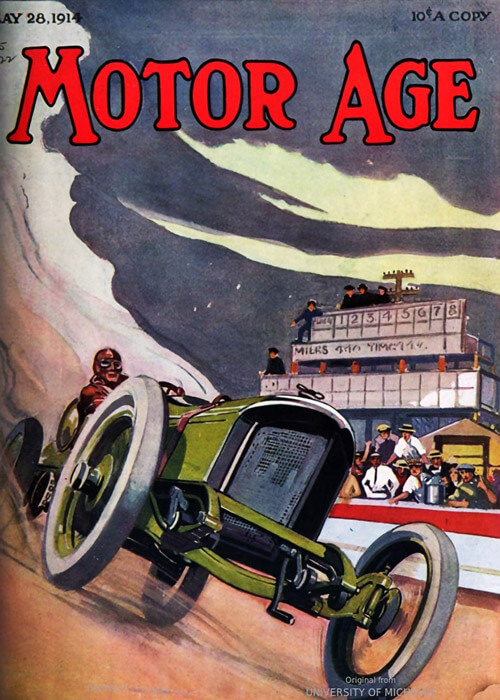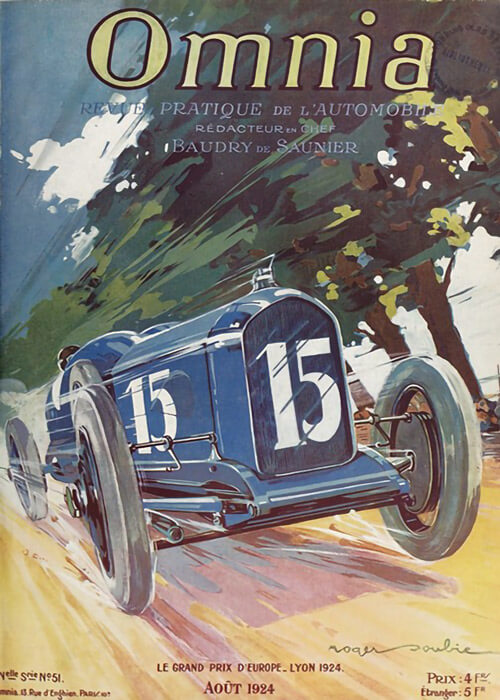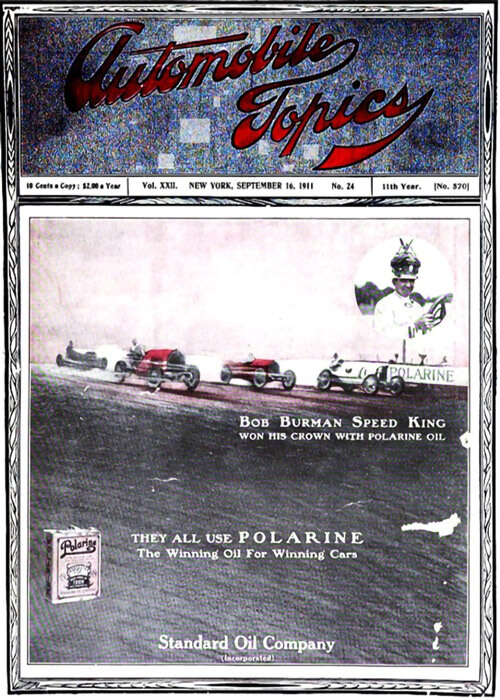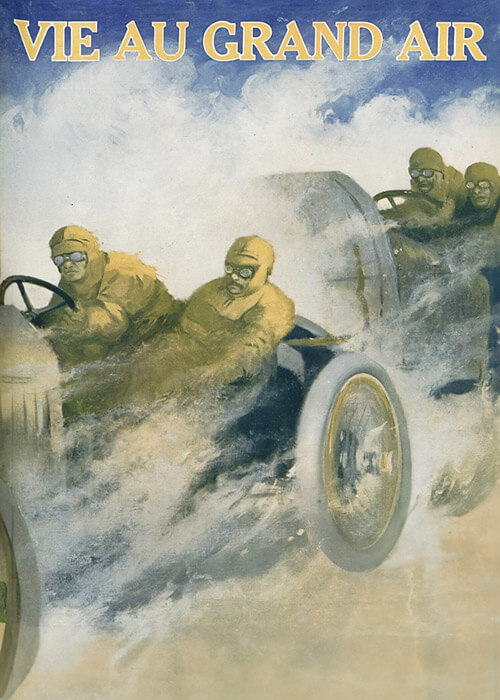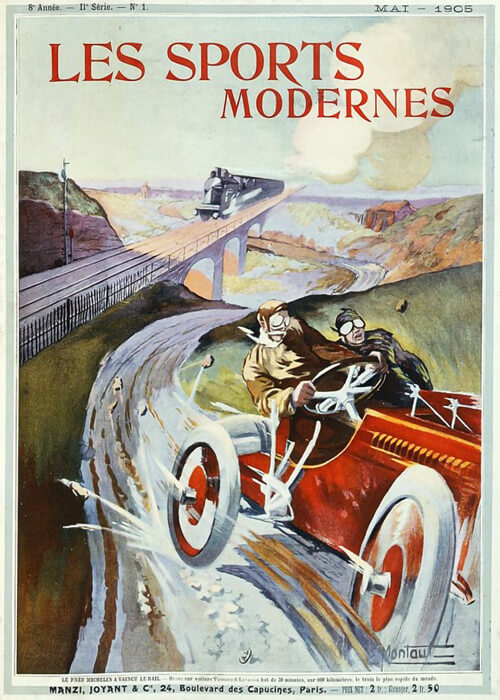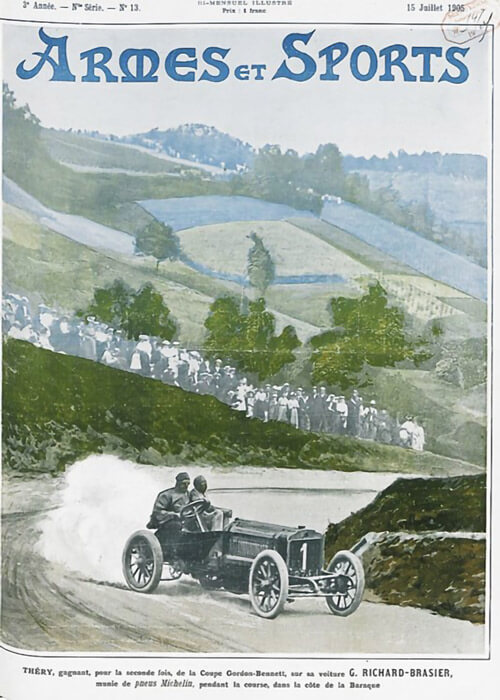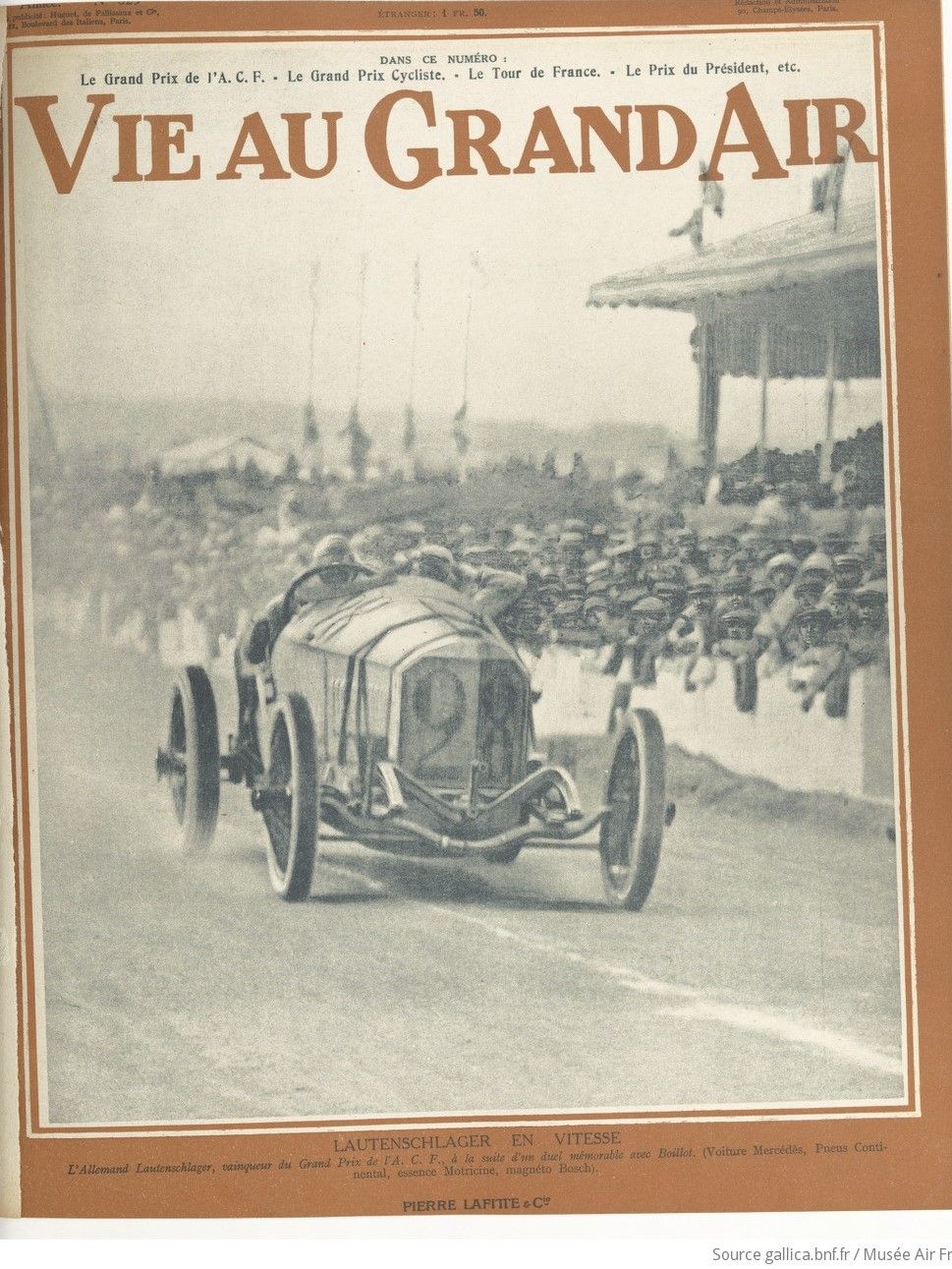
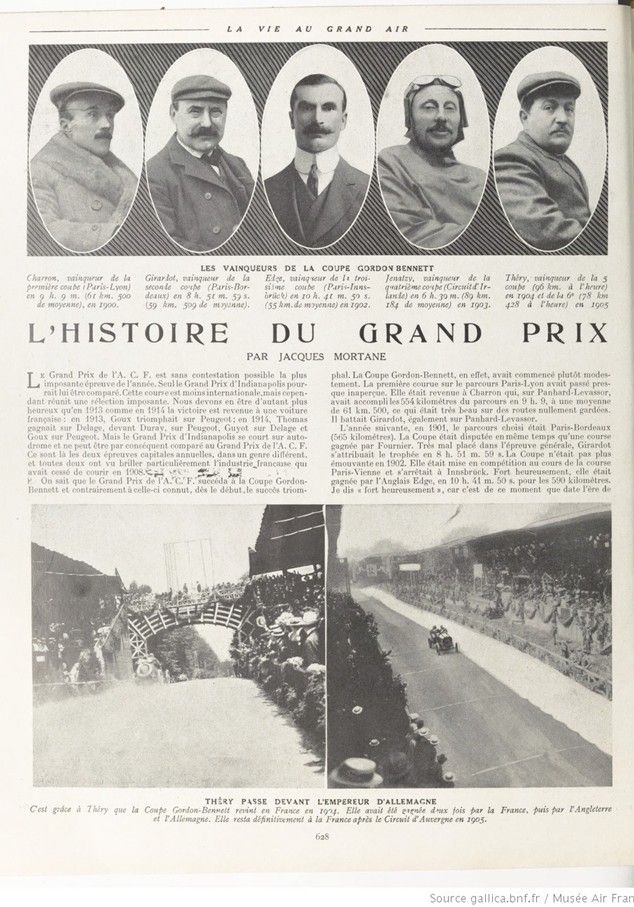
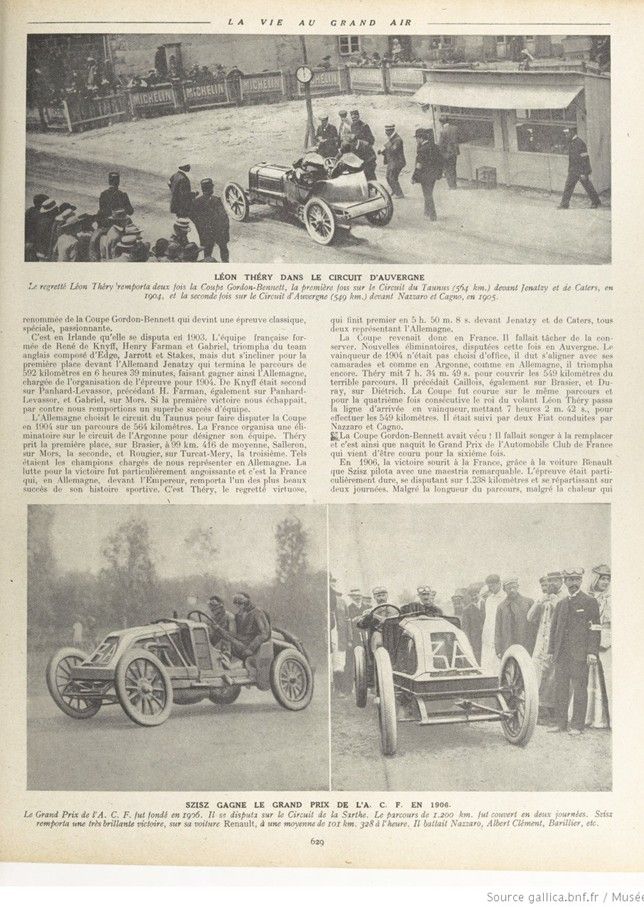
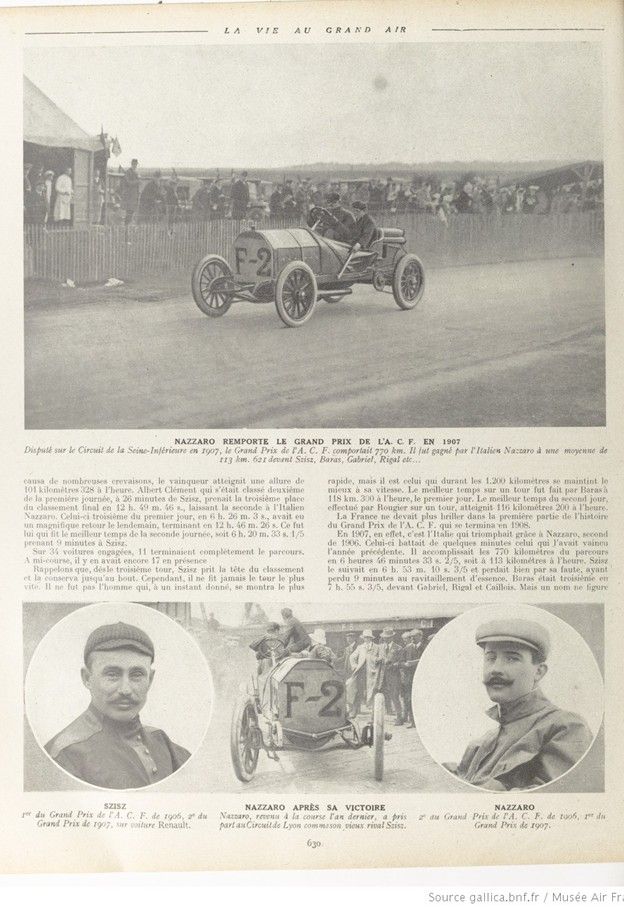
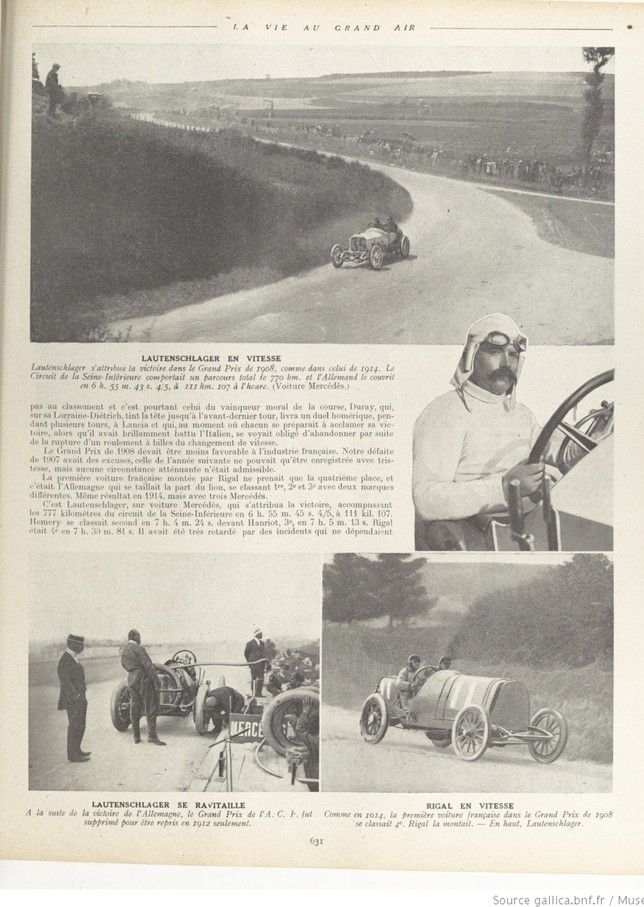
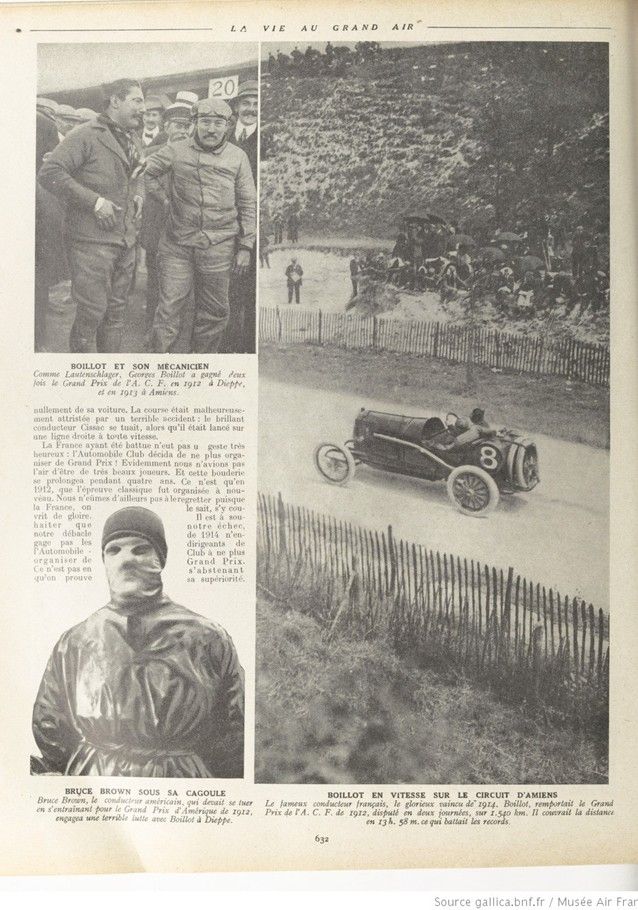
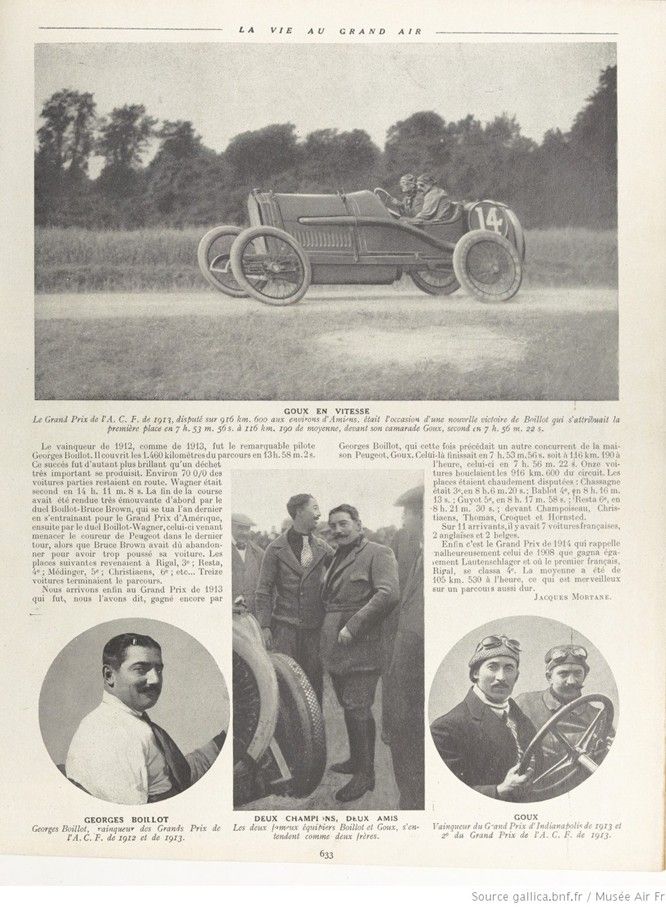
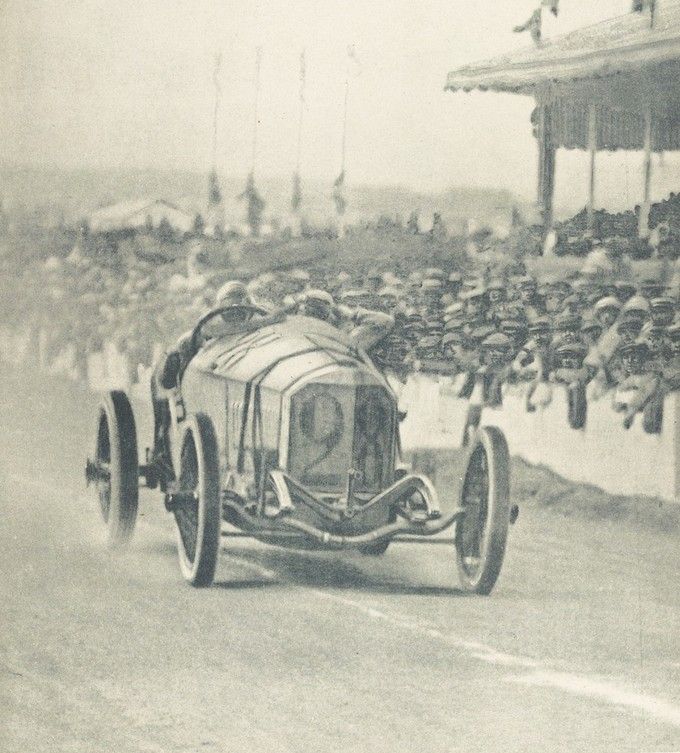
Texte et images jpg compilé par motorracinghistory.com, avec l’autorisation aimable de gallica.bnf.fr / / Bibliothèque national français
La Vie au Grand Air, 17e Année, No. 825, 11 juillet 1914
L’HISTOIRE DU GRAND PRIX
PAR JACQUES MORTANE
LE Grand Prix de l’A. C. F. est sans contestation possible la plus imposante épreuve de l’année. Seul le Grand Prix d’Indianapolis pourrait lui être comparé. Cette course est moins internationale, mais cependant réunit une sélection imposante. Nous devons en être d’autant plus heureux qu’en 1913 comme en 1914 la victoire est revenue à une voiture française : en 1913, Goux triomphait sur Peugeot ; en 1914, Thomas gagnait sur Delage, devant Duray, sur Peugeot, Guyot sur Delage et Goux sur Peugeot. Mais le Grand Prix d’Indianapolis se court sur autodrome et ne peut être par conséquent comparé au Grand Prix de l’A. C. F. Ce sont là les deux épreuves capitales annuelles, dans un genre différent, et toutes deux ont vu briller particulièrement l’industrie française qui avait cessé de courir en 1908.
On sait que le Grand Prix de l’A.C.F. succéda à la Coupe Gordon-Bennett et contrairement à celle-ci connut, dès le début, le succès triomphal. La Coupe Gordon-Bennett, en effet, avait commencé plutôt modestement. La première courue sur le parcours Paris-Lyon avait passé presque inaperçue. Elle était revenue à Charron qui, sur Panhard-Levassor, avait accompli les 554 kilomètres du parcours en 9 h. 9, à une moyenne de 61 km. 500, ce qui était très beau sur des routes nullement gardées. Il battait Girardot, également sur Panhard-Levassor.
L’année suivante, en 1901, le parcours choisi était Paris-Bordeaux (565 kilomètres). La Coupe était disputée en même temps qu’une course gagnée par Fournier. Très mal placé dans l’épreuve générale, Girardot s’attribuait le trophée en 8 h. 51 m. 59 s. La Coupe n’était pas plus émouvante en 1902. Elle était mise en compétition au cours de la course Paris-Vienne et s’arrêtait à Innsbruck. Fort heureusement, elle était gagnée par l’Anglais Edge, en 10 h. 41 m. 50 s. pour les 590 kilomètres. Je dis « fort heureusement », car c’est de ce moment que date l’ère de renommée de la Coupe Gordon-Bennett qui devint une épreuve classique, spéciale, passionnante.
C’est en Irlande qu’elle se disputa en 1903. L’équipe française formée de René de Knyff, Henry Farman et Gabriel, triompha du team anglais composé d’Edge, Jarrott et Stakes, mais dut s’incliner pour la première place devant l’Allemand Jenatzy qui termina le parcours de 592 kilomètres en 6 heures 39 minutes, faisant gagner ainsi l’Allemagne, chargée de l’organisation de l’épreuve pour 1904. De Knyff était second sur Panhard-Levassor, précédant H. Farman, également sur Panhard-Levassor, et Gabriel, sur Mors. Si la première victoire nous échappait, par contre nous remportions un superbe succès d’équipe.
L’Allemagne choisit le circuit du Taunus pour faire disputer la Coupe en 1904 sur un parcours de 564 kilomètres. La France organisa une éliminatoire sur le circuit de l’Argonne pour désigner son équipe. Théry prit la première place, sur Brasier, à 99 km. 416 de moyenne, Salleron, sur Mors, la seconde, et Rougier, sur Turcat-Mery, la troisième. Tels étaient les champions chargés de nous représenter en Allemagne. La lutte pour la victoire fut particulièrement angoissante et c’est la France qui, en Allemagne, devant l’Empereur, remporta l’un des plus beaux succès de son histoire sportive. C’est Théry, le regretté virtuose, qui finit premier en 5 h. 50 m. 8 s. devant Jenatzy et de Caters, tous deux représentant l’Allemagne.
La Coupe revenait donc en France. Il fallait tâcher de la conserver. Nouvelles éliminatoires, disputées cette fois en Auvergne. Le vainqueur de 1904 n’était pas choisi d’office, il dut s’aligner avec ses camarades -et comme en Argonne, comme en Allemagne, il triompha encore. Théry mit 7 h. 34 m. 49 s. pour couvrir les 549 kilomètres du terrible parcours. Il précédait Caillois, également sur Brasier, et Duray, sur Diétrich. La Coupe fut courue sur le même parcours et pour la quatrième fois consécutive le roi du volant Léon Théry passa la ligne d’arrivée en vainqueur, mettant 7 heures 2 m. 42 s., pour effectuer les 549 kilomètres. Il était suivi par deux Fiat conduites par Nazzaro et Cagno.
La Coupe Gordon-Bennett avait vécu ! Il fallait songer à la remplacer et c’est ainsi que naquit le Grand Prix de l’Automobile Club de France qui vient d’être couru pour la sixième fois.
En 1906, la victoire sourit à la France, grâce à la voiture Renault que Szisz pilota avec une maestria remarquable. L’épreuve était particulièrement dure, se disputant sur 1.238 kilomètres et se répartissant sur deux journées. Malgré la longueur du parcours, malgré la chaleur qui causa de nombreuses crevaisons, le vainqueur atteignit une allure de 101 kilomètres 328 à l’heure. Albert Clément qui s’était classé deuxième de la première journée, à 26 minutes de Szisz, prenait la troisième place du classement final en 12 h. 49 m. 46 s., laissant la seconde à l’Italien Nazzaro. Celui-ci troisième du premier jour, en 6 h. 26 m. 3 s., avait eu un magnifique retour le lendemain, terminant en 12 h. 46 m. 26 s. Ce fut lui qui fit le meilleur temps de la seconde journée, soit 6 h. 20 m. 33 s. 1 /5 prenant 9 minutes à Szisz.
Sur 34 voitures engagées, 11 terminaient complètement le parcours. À mi-course, il y en avait encore 17 en présence.
Rappelons que, dès le troisième tour, Szisz prit la tête du classement et la conserva jusqu’au bout. Cependant, il ne fit jamais le tour le plus vit“. Il ne fut pas l’homme qui, à un instant donné, se montra le plus rapide, mais il est celui qui durant les 1.200 kilomètres se maintint le mieux à sa vitesse. Le meilleur temps sur un tour fut fait par Baras à 118 km. 390 à l’heure, le premier jour. Le meilleur temps du second jour, effectué par Rougier sur un tour, atteignit 116 kilomètres 200 à l’heure.
La France ne devait plus briller dans la première partie de l’histoire du Grand Prix de l’A. C. F. qui se termina en 1908.
En 1907, en effet, c’est l’Italie qui triomphait grâce à Nazzaro, second de 1906. Celui-ci battait de quelques minutes celui qui l’avait vaincu l’année précédente. Il accomplissait les 770 kilomètres du parcours en 6 heures 46 minutes 33 s. 2/5, soit à 113 kilomètres à l’heure. Szisz le suivait en 6 h. 53 m. 10 s. 3/5 et perdait bien par sa faute, ayant perdu 9 minutes au ravitaillement d’essence. Baras était troisième en 7 h. 55 s. 3/5, devant Gabriel, Rigal et Caillois. Mais un nom ne figure pas au classement et c’est pourtant celui du vainqueur moral de la course, Duray, qui, sur sa Lorraine-Diétrich, tint la tête jusqu’à l’avant-dernier tour, livra un duel homérique, pendant plusieurs tours, à Lancia et qui, au moment où chacun se préparait à acclamer sa victoire, alors qu’il avait brillamment battu l’Italien, se voyait obligé d’abandonner par suite de la rupture d’un roulement à billes du changement de vitesse.
Le Grand Prix de 1908 devait être moins favorable à l’industrie française. Notre défaite de 1907 avait des excuses, celle de l’année suivante ne pouvait qu’être enregistrée avec tristesse, mais aucune circonstance atténuante n’était admissible.
La première voiture française montée par Rigal ne prenait que la quatrième place, et c’était l’Allemagne qui se taillait la part du lion, se classant 1re, 2e et 3e avec deux marques différentes. Même résultat en 1914, mais avec trois Mercédès.
C’est Lautenschlager, sur voiture Mercédès, qui s’attribua la victoire, accomplissant les 777 kilomètres du circuit de la Seine-Inférieure en 6 h. 55 m. 45 s. 4/5, à 111 kil. 107. Hemery se classait second en 7 h. 4 m. 24 s. devant Hanriot, 3e, en 7 h. 5 m. 13 s. Rigal était 4e en 7 h. 30 m. 81 s. Il avait été très retardé par des incidents qui ne dépendaient nullement de sa voiture. La course était malheureusement attristée par un terrible accident : le brillant conducteur Cissac se tuait, alors qu’il était lancé sur une ligne droite à toute vitesse.
La France ayant été battue n’eut pas un geste très heureux : l’Automobile Club décida de ne plus organiser de Grand Prix ! Evidemment nous n’avions pas l’air d’être de très beaux joueurs. Et cette bouderie se prolongea pendant quatre ans. Ce n’est qu’en 1912, que l’épreuve classique fut organisée à nouveau. Nous n’eûmes d’ailleurs pas à le regretter puisque la France, on le sait, s’y couvrit de gloire.
Il est à souhaiter que notre échec, notre débâcle de 1914 n’engage pas les dirigeants de l’Automobile – Club à ne plus organiser de Grand Prix.
Ce n’est pas en s’abstenant qu’on prouve sa supériorité.
Le vainqueur de 1912, comme de 1913, fut le remarquable pilote Georges Boillot. Il couvrit les 1.460 kilomètres du parcours en 13 h. 58 m. 2 s. Ce succès fut d’autant plus brillant qu’un déchet très important se produisit. Environ 70% des voitures parties restaient en route. Wagner était second en 14 h. 11 m. 8 s. La fin de la course avait été rendue très émouvante d’abord par le duel Boillot-Bruce Brown, qui se tua l’an dernier en s’entraînant pour le Grand Prix d’Amérique, ensuite par le duel Boillot-Wagner, celui-ci venant menacer le coureur de Peugeot dans le dernier tour, alors que Bruce Brown avait dû abandonner pour avoir trop poussé sa voiture. Les places suivantes revenaient à Rigal, 3e ; Resta, 4e ; Médinger, 5e ; Christiaens, 6e ; etc… Treize voitures terminaient le parcours.
Nous arrivons enfin au Grand Prix de 1913 qui fut, nous l’avons dit, gagné encore par Georges Boillot, qui cette fois précédait un autre concurrent de la maison Peugeot, Goux. Celui-là finissait en 7 h. 53 m. 56 s. soit à 1,16 km. 190 à l’heure, celui-ci en 7 h. 56 m. 22 s. Onze voitures bouclaient les 916 km. 600 du‘ circuit. Les places étaient chaudement disputées : Chassagne était 3e, en 8 h.6 m.20 s. ; Bablot 4e, en 8 h. 16 m. 13 s. ; Guyot 5e, en 8 h. 17 m. 58 s. ; Resta 6e, en 8 h. 21 m. 30 s. ; devant Champoiseau, Christiaens, Thomas, Croquet et Hornsted.
Sur 11 arrivants, il y avait 7 voitures françaises, 2 anglaises et 2 belges.
Enfin c’est le Grand Prix de 1914 qui rappelle malheureusement celui de 1908 que gagna égaiement Lautenschlager et où le premier français, Rigal, se classa 4e. La moyenne a été de 105 km. 530 à l’heure, ce qui est merveilleux sur un parcours aussi dur.
JACQUES MORTANE.
Commentaires aux photos.
LES VAINQUEURS DE LA. COUPE GORDON BENNETT
Charron, vainqueur de la première coupe (Paris- Lyon) en 9 h. 9 m. (61 km. 500 de moyenne), en 1900.
Girardot, vainqueur de la seconde coupe (Paris-Bordeaux) en 8 h. 51 m. 59 s. (59 km. 509 de moyenne).
Edge, vainqueur de la troisième coupe (Paris-Innsbruck) en 10 h. 41 m. 50 s. (55 km. de moyenne) en 1902.
Jenatzv, vainqueur de la quatrième coupe (Circuit d’Irlande) en 6 h. 30 m. (89 km. 184 de moyenne) en 1903.
Théry, vainqueur de la 5 coupe (96 km. à l’heure) en 1904 et de la 6e (78 km 428 à l’heure) en 1905
THÉRY PASSE DEVANT L’EMPEREUR D’ALLEMAGNE – C’est grâce à Théry que la Coupe Gordon-Bennett revint en France en 1904. Elle avait été gagnée deux fois Par la France, puis par l’Angleterre et l’Allemagne. Elle resta définitivement à la France après le Circuit d’Auvergne en I905.
Page 629 :
LÉON THÉRY DANS LE CIRCUIT D’AUVERGNE – Le regretté Léon Théry ‚remporta, deux fois la Coupe Gordon-Bennett, la première fois sur le Circuit du Taunus (564 km.) devant Jenatzy et de Caters, en I904, et la seconde fois sur le Circuit d’Auvergne (g49 km.) devant Nazzaro et Cagno, en I905.
SZISZ GAGNE LE GRAND PRIX DE L’A. C. F. EN 1906. – Le Grand Prix de l’A. C. F. fut fondé en 19()6. Il se disputa sur le Circuit de la Sirthe. Le parcours de 1.200 km. fut couvert en deux journées. Szisz remporta une très brillante victoire, sur sa voiture Renault, à une moyenne de 101 km. 328 à l’heure. Il battait Nazzaro, Albert Clément, Barillier, etc.
Page 630 :
NAZZARO REMPORTE LE GRAND PRIX DE L’A. C. F. EN 1907 – Disputé sur le Circuit de la Seine-Inférieure en I907, le Grand Prix de l’A. C. F. comportait 770 km. Il fut gagné par l’Italien Nazzaro à une moyenne de 113 km. 621 devant Szisz, Baras, Gabriel, Rigal etc…
SZISZ – 1er du Grand Prix de l’A. C. F. de 1906, 2e du Grand Prix de 1907, sur voiture Renault.
NAZZARO APRÈS SA VICTOIRE – Nazzaro, revenu à la course l’an dernier, a pris part au Circuit de Lyon comme son vieux rival Szisz.
NAZZARO – 2e du Grand Prix de l’A. C. F. de 1906, 1Ier du Grand Prix de 1907.
Page 631
LAUTENSCHLAGER EN VITESSE – Lautenschlager s’attribua la victoire dans le Grand Prix de igo8, comme dans celui de 1914. Le Circuit de la Seine- Inférieure comportait un parcours total de 770 km. et l’Allemand le couvrit en 6 h. 55 m. 43 s. 415, à iii km. I07 à l’heure. (Voiture Mercédès.)
LAUTENSCHLAGER SE RAVITAILLE – A la suite de la victoire de l’Allemagne, le Grand Prix de l’A. C. r. fut supprimé pour être repris en IQ12 seulement.
RIGAL EN VITESSE – Comme en 1014, la première voiture française dans le Grand Prix de 1908 se classait 4e. Rigal la montait. — En haut, Lautenschlager.
Page 632
BOILLOT ET SON MÉCANICIEN – Comme Lautenschlager, Georges Boillot a gagné deux fois le Grand Prix de l’A. C. F. en 1912 à Dieppe, et en 1913 à Amiens.
BRUCE BROWN SOUS SA CAGOULE – Bruce Brown, le conducteur américain, qui devait se tuer en s’entraînant pour le Grand Prix d’Amérique de 1912, engagea une terrible lutte avec Boillot à Dieppe.
BOILLOT EN VITESSE SUR LE CIRCUIT D’AMIENS – Le fameux conducteur français, le glorieux vaincu de 1914, Boillot, remportait le Grand Prix de l’A. C. F. de 1902, disputé en deux journées, sur 1.540 km. Il couvrait la distance en 13 h. 58 m. ce qui battait les records.
Page 633
GOUX EN VITESSE – Le Grand Prix de l’A. C. F. de igil, disputé sur 9r6 km. 600 aux environs d’Amiens, était l’occasion d’une nouvelle victoire de Boillot qui s’attribuait la première Place en 7 h. 53 m. 56 s. à 116 km. 190 de moyenne, devant son camarade Goux, second en 7 h. 56 m. 22 s.
GEORGES BOILLOT – Georges Boillot, vainqueur des Grands Prix de l’A. C. F. de 1912 et de I9I3.
DEUX CHAMPIONS, DEUX AMIS – Les deux fameux équipiers Boillot et Goux, s’entendent comme deux frères.
GOUX – Vainqueur du Grand Prix d’Indianapolis de 1913 et 2e du Grand Prix de l’A. C. F. de 1913.
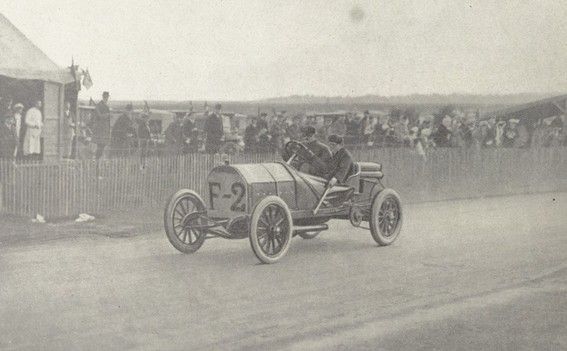
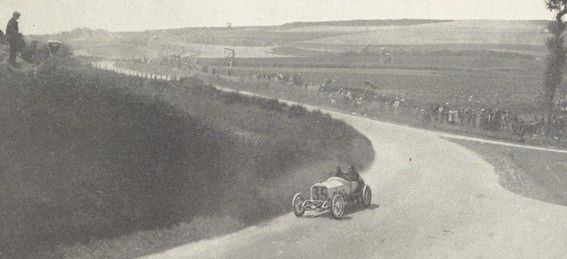
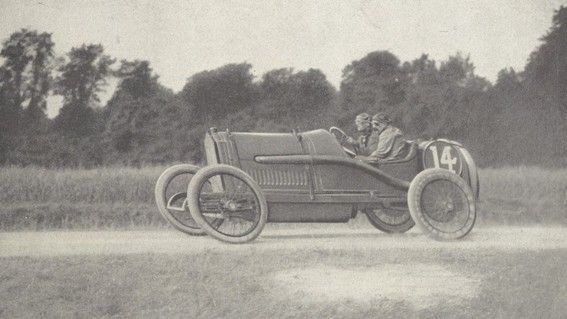
Translation by DeepL.com
LA VIE AU GRAND AIR (~Life in the open) – 11 july 1914
THE HISTORY OF THE GRAND PRIX BY JACQUES MORTANE
The A. C. F. Grand Prix is without question the most impressive event of the year. Only the Indianapolis Grand Prix could compare with it. This race is less international, but nevertheless brings together an impressive selection. We should be all the more pleased that in 1913 and 1914 the victory went to a French car: in 1913, Goux triumphed in a Peugeot; in 1914, Thomas won in a Delage, ahead of Duray in a Peugeot, Guyot in a Delage and Goux in a Peugeot. But the Indianapolis Grand Prix is run on a speedway and cannot therefore be compared to the A.C.F. Grand Prix. These are the two major annual events, in a different genre, and both have seen the particular brilliance of French industry, which had stopped racing in 1908.
We know that the A.C.F. Grand Prix succeeded the Gordon-Bennett Cup and, unlike the latter, enjoyed triumphant success from the outset. The Gordon-Bennett Cup, in fact, had started out rather modestly. The first one, run on the Paris-Lyon course, had gone almost unnoticed. It had been won by Charron, who had completed the 554-kilometer course in 9 hours and 9 minutes, at an average of 61 km/h, in a Panhard-Levassor. 500, which was very good on roads with no traffic controls.
He beat Girardot, also in a Panhard-Levassor.
The following year, in 1901, the chosen route was Paris-Bordeaux (565 kilometers). The Cup was contested at the same time as a race won by Fournier. Very poorly placed in the general event, Girardot took the trophy in 8 hours, 51 minutes and 59 seconds. The Cup was no more exciting in 1902. It was contested during the Paris-Vienna race and ended in Innsbruck. Fortunately, it was won by the Englishman Edge, in 10 hours, 41 minutes and 50 seconds for the 590 kilometers. I say “fortunately” because it was from that moment that the Gordon Bennett Cup became a renowned, classic, special and exciting event.
It was held in Ireland in 1903. The French team, made up of René de Knyff, Henry Farman and Gabriel, triumphed over the English team, made up of Edge, Jarrott and Stakes, but had to yield first place to the German Jenatzy, who completed the 592-kilometer course in 6 hours 39 minutes, thus ensuring victory for Germany, which was responsible for organizing the event in 1904. De Knyff came second in a Panhard-Levassor, ahead of H. Farman, also in a Panhard-Levassor, and Gabriel, in a Mors. Although we missed out on the first victory, we did achieve a superb team success.
Germany chose the Taunus circuit for the 1904 Cup, on a 564-kilometer course. France organized a qualifying round on the Argonne circuit to select its team. Théry took first place, on Brasier, at 99 km. 416 on average, Salleron, on Mors, second, and Rougier, on Turcat-Mery, third. These were the champions charged with representing us in Germany. The fight for victory was particularly nerve-racking and it was France that, in Germany, in front of the Emperor, won one of the greatest successes in its sporting history. It was Théry, the late virtuoso, who finished first in 5 hours 50 minutes and 8 seconds, ahead of Jenatzy and de Caters, both representing Germany.
The Cup therefore returned to France. They had to try to keep it. New elminatories, this time held in Auvergne. The 1904 winner was not automatically chosen, he had to line up with his comrades – and as in Argonne, as in Germany, he triumphed again. Théry took 7 hours 34 minutes and 49 seconds to cover the 549 kilometers of the terrible course. He finished ahead of Caillois, also on Brasier, and Duray, on Diétrich. The Cup was run on the same course and for the fourth time in a row the king of the wheel Léon Théry crossed the finish line as the winner, taking 7 hours 2 minutes and 42 seconds to cover the 549 kilometers. He was followed by two Fiats driven by Nazzaro and Cagno.
The Gordon Bennett Cup was no more! It was time to think about replacing it, and so the Grand Prix of the Automobile Club de France was born, and has just been run for the sixth time.
In 1906, victory smiled on France, thanks to the Renault car that Szisz drove with remarkable skill. The event was particularly tough, covering 1,238 kilometers and taking place over two days. Despite the length of the course, and the heat that caused numerous punctures, the winner reached a speed of 101 kilometers 328 per hour. Albert Clément, who had come second on the first day, 26 minutes behind Szisz, took third place in the final ranking in 12 hours, 49 minutes and 46 seconds, leaving second place to the Italian Nazzaro. Nazzaro, who was third on the first day in 6 hours, 26 minutes and 3 seconds, made a magnificent comeback the following day, finishing in 12 hours, 46 minutes and 26 seconds. 46 m. 26 s. He also achieved the best time on the second day, 6 h. 20 m. 33 s. 1 /5, taking 9 minutes from Szisz.
Of the 34 cars entered, 11 completed the course. At the halfway point, there were still 17 in the running.
Remember that, from the third lap, Szisz took the lead and held it until the end. However, he never did the fastest lap. He was not the man who, at any given moment, was the fastest, but he was the one who, over the 1,200 kilometers, maintained his speed the best. The best lap time was achieved by Baras at 118 km. 390 per hour on the first day. The best time on the second day, achieved by Rougier on one lap, reached 116 kilometers 200 per hour.
France was not to shine again in the first part of the history of the A.C.F. Grand Prix, which ended in 1908.
In 1907, Italy triumphed thanks to Nazzaro, who had finished second in 1906. He beat the man who had beaten him the previous year by a few minutes. He completed the 770-kilometer course in 6 hours 46 minutes 33.25 seconds, or at 113 kilometers per hour. Szisz followed him in 6 hrs. 53 mins. 10 sec. 3/5 and lost a lot through his own fault, having lost 9 minutes at the refueling station. Baras was third in 7 hrs. 55 sec. 3/5, ahead of Gabriel, Rigal and Caillois. But one name does not appear in the ranking and yet it is that of the moral winner of the race, Duray, who, on his Lorraine-Dietrich, held the lead until the penultimate lap, fought a Homeric duel with Lancia for several laps and who, just as everyone was preparing to acclaim his victory, after he had brilliantly beaten the Italian, found himself forced to abandon as a result of a broken ball bearing in the gearbox.
The 1908 Grand Prix was to be less favorable to French industry. Our defeat in 1907 had excuses, that of the following year could only be recorded with sadness, but no extenuating circumstances were admissible.
The first French car, driven by Rigal, only managed fourth place, and it was Germany that took the lion’s share, with two different makes finishing 1st, 2nd and 3rd. The same result in 1914, but with three Mercedes.
Lautenschlager, in a Mercedes, took the victory, completing the 777 kilometers of the Seine-Inférieure circuit in 6 hours 55 minutes 45.45/45ths of a second, at 111 kilometers per hour. Hemery came second in 7 hours 4 minutes 24 seconds, ahead of Hanriot in 3rd place in 7 hours 5 minutes 13 seconds. Rigal was 4th in 7 hours 30 minutes 81 seconds. He had been delayed considerably by incidents that were in no way his car’s fault. The race was unfortunately saddened by a terrible accident: the brilliant driver Cissac was killed, while he was speeding down a straight line.
France having been beaten did not make a very happy gesture: the Automobile Club decided to no longer organize Grand Prix races! Obviously we didn’t look like very good players. And this sulking continued for four years. It was not until 1912 that the classic event was organized again. We did not have to regret it, as France, as we know, covered itself with glory.
It is to be hoped that our failure, our debacle of 1914, will not lead the directors of the Automobile Club to stop organizing the Grand Prix.
Abstaining is no way to prove your superiority.
The winner in 1912, as in 1913, was the remarkable driver Georges Boillot. He covered the 1,460 kilometers of the course in 13 hours, 58 minutes and 2 seconds. This success was all the more brilliant as there was a very high rate of attrition. Around 70% of the cars that started the race did not finish. Wagner came second in 14 hours, 11 minutes and 8 seconds. 11 m. 8 s. The end of the race was made very exciting first by the Boillot-Bruce Brown duel, who was killed last year while training for the Grand Prix d’Amérique, then by the Boillot-Wagner duel, the latter threatening the Peugeot driver on the last lap, while Bruce Brown had to give up for having pushed his car too hard. The following places went to Rigal, 3rd; Resta, 4th; Médinger, 5th; Christiaens, 6th; etc. Thirteen cars finished the race.
Finally, we come to the 1913 Grand Prix which, as we have said, was won once again by Georges Boillot, who this time finished ahead of another Peugeot competitor, Goux. Goux finished in 7 hours, 53 minutes and 56 seconds, or 1.16 km. 190 per hour, this one in 7 hours 56 minutes 22 seconds. Eleven cars completed the 916 km. 600 of the circuit. The places were hotly contested: Chassagne was 3rd, in 8 hours 6 minutes 20 seconds; Bablot 4th, in 8 hours 16 minutes 13 s.; Guyot 5th, in 8 h. 17 m. 58 s.; Resta 6th, in 8 h. 21 m. 30 s.; ahead of Champoiseau, Christiaens, Thomas, Croquet and Hornsted.
Of the 11 finishers, there were 7 French cars, 2 English and 2 Belgian.
Finally, it was the 1914 Grand Prix that unfortunately recalled the 1908 one, also won by Lautenschlager, and where the first Frenchman, Rigal, came 4th. The average speed was 105 km. 530 per hour, which is wonderful on such a tough course. JACQUES MORTANE.
Photo captions.
Page 628:
THE WINNERS OF THE GORDON BENNETT CUP
Charron, winner of the first cup (Paris-Lyon) in 9 hours 9 minutes (average of 61.5 km) in 1900.
Girardot, winner of the second cup (Paris-Bordeaux) in 8 hrs. 51 mins. 59 secs. (average of 59.509 km) in 1902.
Edge, winner of the third cup (Paris-Innsbruck) in 10 hrs. 41 mins. 50 secs. (average of 55 km) in 1902.
Jenatzv, winner of the fourth cup (Irish Circuit) in 6 hrs. 30 mins. (89 km. 184 average) in 1903.
Théry, winner of the 5th cup (96 km. per hour) in 1904 and the 6th (78 km 428 per hour) in 1905.
THÉRY PASSES IN FRONT OF THE GERMAN EMPEROR – It was thanks to Théry that the Gordon Bennett Cup returned to France in 1904. It had been won twice by France, then by England and Germany. It remained definitively in France after the Circuit d’Auvergne in 1905.
Page 629:
LÉON THÉRY IN THE CIRCUIT D’AUVERGNE – The late Léon Théry won the Gordon Bennett Cup twice, the first time on the Taunus Circuit (564 km) ahead of Jenatzy and de Caters in 1904, and the second time on the Auvergne Circuit (49 km) ahead of Nazzaro and Cagno in 1905.
SZISZ WON THE A. C. F. GRAND PRIX IN 1906. – The A. C. F. Grand Prix was founded in 19()6. It was held on the Circuit de la Sarthe. The 1,200 km course was covered in two days. Szisz won a brilliant victory in his Renault car, at an average of 101 km. 328 per hour. He beat Nazzaro, Albert Clément, Barillier, etc.
Page 630:
NAZZARO WINS THE A. C. F. GRAND PRIX IN 1907 – Contested on the Seine-Inférieure Circuit in 1907, the A. C. F. Grand Prix covered 770 km. It was won by the Italian Nazzaro at an average of 113 km. 621 ahead of Szisz, Baras, Gabriel, Rigal etc…
SZISZ – 1st in the 1906 A. C. F. Grand Prix, 2nd in the 1907 Grand Prix, in a Renault car.
NAZZARO AFTER HIS VICTORY – Nazzaro, who returned to racing last year, took part in the Circuit de Lyon like his old rival Szisz.
NAZZARO – 2nd in the 1906 A. C. F. Grand Prix, 1st in the 1907 Grand Prix.
Page 631
LAUTENSCHLAGER AT SPEED – Lautenschlager claimed victory in the 1908 Grand Prix, as he did in 1914. The Circuit de la Seine-Inférieure had a total distance of 770 km, and the German covered it in 6 hours, 55 minutes, 43 seconds, 415.307 km/h. (Mercedes car.)
LAUTENSCHLAGER Refuels – Following Germany’s victory, the A. C. F. Grand Prix was canceled and not resumed until 1912.
RIGAL AT SPEED – As in 1014, the first French car in the 1908 Grand Prix came in 4th. Rigal was driving it. — Above, Lautenschlager.
Page 632
BOILLOT AND HIS MECHANIC – Like Lautenschlager, Georges Boillot won the A.C.F. Grand Prix twice, in 1912 in Dieppe and in 1913 in Amiens.
BRUCE BROWN UNDER HIS COVER – Bruce Brown, the American driver, who was to kill himself while training for the 1912 Grand Prix d’Amérique, engaged in a terrible struggle with Boillot in Dieppe.
BOILLOT AT SPEED ON THE AMIENS CIRCUIT – The famous French driver, the glorious loser of 1914, Boillot, won the 1902 A.C.F. Grand Prix, contested over two days, over 1,540 km. He covered the distance in 13 hours and 58 minutes, breaking the record.
Page 633
GOUX ON THE MOVE – The A. C. F. de 1913 Grand Prix, contested over 9r6 km. 600 in the vicinity of Amiens, was the occasion for a new victory for Boillot, who took first place in 7 h. 53 m. 56 s. at 116 km. 190 average, ahead of his teammate Goux, second in 7 hrs. 56 mins. 22 secs.
GEORGES BOILLOT – Georges Boillot, winner of the A. C. F. Grand Prix in 1912 and 1913.
TWO CHAMPIONS, TWO FRIENDS – The two famous team-mates Boillot and Goux got on like two brothers.
GOUX – Winner of the 1913 Indianapolis Grand Prix and 2nd in the 1913 A. C. F. Grand Prix.
